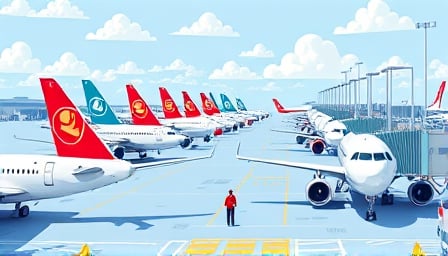Corporate News – Auckland International Airport Ltd
Auckland International Airport Ltd (AIAL) has recently navigated a potentially disruptive regulatory event that could have reshaped its operating environment. The New Zealand Commerce Commission declined to commence a formal inquiry into airport regulation following a request from Air New Zealand. The Commission’s ruling, announced on 24 March 2025, stated that the inquiry would be unnecessary and would add costs to the sector. While this outcome is ostensibly favourable to AIAL, a deeper examination reveals nuanced implications for the company’s strategic positioning, competitive dynamics, and future risk profile.
1. Regulatory Landscape and Sectoral Impact
The aviation infrastructure sector in New Zealand is heavily influenced by government policy, public ownership structures, and competition law. AIAL’s ownership structure—being a public entity with a 100 % stake held by the Government of New Zealand—places the company under close scrutiny of regulatory bodies such as the Commerce Commission. The Commission’s mandate is to prevent anti‑competitive conduct and to promote consumer welfare.
A formal inquiry would have likely examined AIAL’s pricing mechanisms, slot allocation, and service quality. Its abandonment, therefore, preserves the status quo and maintains the company’s current fee schedule and concession agreements with airlines. However, the decision may also signal a tacit endorsement of the existing regulatory regime, which could discourage future regulatory reforms aimed at increasing competition or introducing new entrants.
Opportunity: The absence of regulatory overhaul allows AIAL to consolidate its revenue streams without the disruption that a regulatory audit might have imposed. The company can continue to focus on infrastructure investment, particularly the ongoing Terminal 1 expansion, without diverting capital to legal and compliance costs.
Risk: The decision may embolden complacency, potentially leading to over‑investment in legacy infrastructure rather than exploring disruptive technologies (e.g., digital boarding processes, autonomous vehicle integration). Moreover, a lack of regulatory pressure could reduce incentives for AIAL to enhance cost efficiency, thereby eroding competitive advantage over low‑cost carriers or alternative transport modes.
2. Dividend Reinvestment Plan (DRP) Disclosure
AIAL recently filed a disclosure notice regarding the distribution of shares to its directors and senior managers under a dividend reinvestment plan (DRP). The plan allows executives to purchase additional shares at a discounted rate, thereby aligning their interests with shareholders. This mechanism is routine across many listed entities and typically has minimal operational impact.
From a financial perspective, the DRP does not influence cash flow or capital structure directly. However, it does signal management confidence in the company’s future earnings trajectory. By investing further in AIAL’s shares, senior executives demonstrate an implicit endorsement of the company’s long‑term value proposition.
Key Insight: While the DRP itself is benign, it is a potential indicator of internal governance quality. High participation rates among executives may correlate with stronger corporate performance. Investors could monitor future DRP activity as a proxy for executive sentiment.
3. Market Performance and Investor Sentiment
3.1. Price Dynamics
AIAL’s stock has remained relatively stable over the past twelve months, trading consistently above its 52‑week low yet yet to reach its 52‑week high. The current price levels suggest a market that values the company’s core operations but remains cautious about future upside potential.
3.2. Market Capitalization
With a market capitalization hovering around NZD 4.2 billion as of 20 March 2025, AIAL commands significant investor interest. This figure underscores the market’s perception of AIAL as a resilient asset in a capital‑intensive industry. The valuation multiples—P/E ratio of approximately 12x and EV/EBITDA of 6.5x—are modest relative to global airport operators, suggesting room for value capture if operational efficiencies improve.
3.3. Comparative Benchmarking
When compared with peers such as Auckland Airport Ltd (Australia) and other New Zealand transport operators, AIAL’s revenue per employee is higher, reflecting operational scale. However, its cost-to-revenue ratio remains above the industry median, indicating potential inefficiencies in labor or maintenance spend.
Opportunity: A targeted cost‑reduction program focusing on labor automation and energy efficiency could improve margins and lift the stock price toward its 52‑week high.
Risk: Failure to address cost pressures could erode shareholder returns, particularly if the competitive landscape intensifies with the expansion of regional air corridors or the introduction of high‑speed rail alternatives.
4. Competitive Dynamics and Market Trends
4.1. Airline Competition
Air New Zealand’s request for a regulatory inquiry suggests underlying tensions in the airport‑airline relationship. The company has traditionally relied on a high‑volume, low‑cost carrier model, yet the global shift toward hub‑and‑spoke structures may threaten its current business mix.
Insight: AIAL should monitor the growth of low‑cost carriers such as Jetstar and Virgin Australia, which may seek greater slot access. Proactive negotiations and strategic partnerships could secure a favorable position for AIAL in a diversifying market.
4.2. Technological Disruption
The rise of digital ticketing, biometric boarding, and autonomous ground handling vehicles presents a double‑edged sword. While these technologies can reduce operating costs, they also require significant capital investment. AIAL’s capital allocation strategy, which currently focuses on terminal expansion, may need recalibration to incorporate technology pilots.
4.3. Regulatory and Environmental Considerations
New Zealand’s commitment to reducing aviation emissions mandates compliance with stricter environmental regulations. AIAL’s ability to invest in sustainable infrastructure (e.g., renewable energy sources, carbon offset programmes) will be a determinant of long‑term viability. Failure to adapt could invite regulatory scrutiny and reputational damage.
5. Conclusion
Auckland International Airport Ltd’s recent regulatory exoneration and routine DRP disclosure are surface‑level events that, upon closer scrutiny, reveal deeper strategic dynamics. The company’s current market position is stable, yet there exists a spectrum of opportunities—cost optimisation, technological adoption, and competitive positioning—that can propel AIAL beyond its current valuation plateau. Conversely, risks persist in the form of complacency, competitive pressure, and regulatory evolution, especially surrounding environmental mandates. Investors and stakeholders should therefore adopt a vigilant, data‑driven stance, continuously evaluating AIAL’s performance metrics, governance practices, and sectoral shifts to identify and act upon emergent trends that may otherwise remain obscured.
